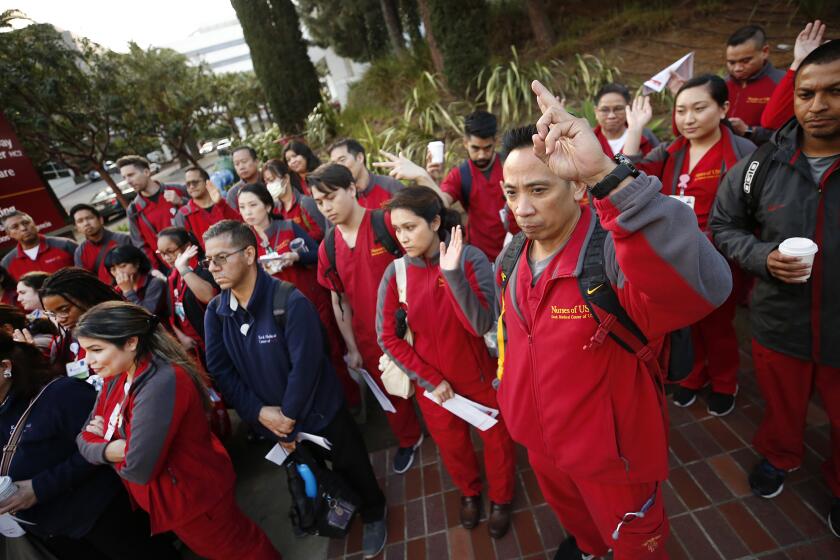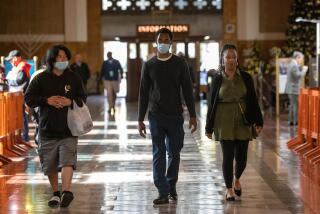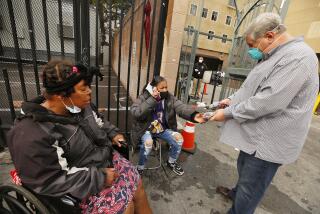Third coronavirus cluster found in San Diego County
- Share via
A third cluster of COVID-19 patients in San Diego was announced Thursday, as the local count of virus cases jumped from 80 to 105 and efforts to house vulnerable people in local hotels progressed.
It was the second day in a row that the region has set a single-day record for newly reported cases of novel coronavirus in the community.
Public health officials shed little light Thursday on the particulars of how the newest group of individuals were infected, saying only that the cluster’s illness was connected to travel.
Dr. Eric McDonald, medical director of epidemiology and immunization services for the county, said one of two clusters announced earlier this week — the one involving a group exposed during a skiing trip to Colorado — has expanded from seven members to 10.
There was no change for the third grouping, which involves four people who did not travel out of the area.
But that’s just the horse race. Public health officials at the county’s afternoon news conference stressed that the public should not get too fixated on numbers increasing — because they don’t come close to capturing the true scale of what’s among us.
With testing still not available to everyone who is showing symptoms, and such diagnostics still reserved for those sick enough to need medical attention, the vast majority of cases likely in the community remain statistically invisible.
“I would estimate that at least 10 times as many cases are actually out there than we are detecting, at least,” McDonald said, speaking after Thursday’s news conference.
“That’s why we’re doing what we’re doing, so that those individuals that we’re not detecting, hopefully, all are isolating themselves at home and not spreading it around.”
So far, even as the number of confirmed cases has increased each day, the region has not yet seen any deaths. Only 11 people have gotten sick enough to check into a local hospital.
But that doesn’t mean some aren’t suffering. Though the novel coronavirus has gotten a reputation for delivering the grimmest consequences to those who are older, McDonald warned there is still plenty of risk to go around.
Currently, the most fraught COVID-19 fight in the region is being waged by a young person.
“We have one very sick patient in the hospital right now who’s only 31 years old,” McDonald said. “Yes, it’s true that the older you are, the higher your risk, but just because you’re young doesn’t mean you’re not going to get that disease.”
Nurses seek masks
Recently implemented supply conservation measures in local hospitals, which have sought to reduce the “burn rate” of vital personal protective equipment, continue to frustrate front-line workers, who told the San Diego Union-Tribune that they are not getting the supplies they need to keep themselves from picking up COVID-19 infections from patients.
One UC San Diego nurse, who asked not to be named for fear of employment consequences, said many feel that hospitals’ decision to move away from issuing health workers N95 respirators for routine care and surgical masks in many other situations, could end up creating a wave of infections among the very health care workers whose skills will soon be in huge demand.
Healthcare workers say they are at greater risk of the coronavirus because of a switch to less safe face masks
“We fear that, without effective gear, eventually the public will be hurt because there is going to be a shortage in staff,” the nurse said.
McDonald said he hears that concern. As an emergency doctor for 25 years, he said he considers those on the front lines “my people” and wants desperately to protect everyone.
But he added that in a world where literally every health system is ordering as much of this gear as they can, it has been necessary to rein in a culture of gowning up to the nth degree, even if less materiel could still get the job done just as effectively.
McDonald said he has read the best studies he can find on infections among health care workers in China, where personal protective equipment was scarce for months, and many had to work without protective equipment in situations where they usually wouldn’t.
In general, he said, face masks and eye protection have been shown by the experience in China to be what’s needed, unless workers are doing procedures likely to spray water droplets into the air.
“If you look at the evidence of the experience in China, all of those health care workers who got infected — guess where they got infected,” McDonald said.
“They got infected at home. When they did the case contact tracing, the vast majority of the health care workers that were infected in China were infected at their homes, not in the health care environment, even though they were doing all of these spartan things like reusing equipment and that sort of thing.”
The overall availability of personal protective equipment is of extreme concern in the health care community.
Asked to quantify the relative fullness of the region’s supply closet, Dr. Wilma Wooten, the county’s public health officer, said that current conservation efforts have left the county with a reserve supply of about 700,000 N95 respirator masks and about 70,000 surgical masks. Inventory is tighter, she said, for gowns, gloves and goggles, though she did not have access to the stocking levels of those items.
“We have no shortage with N95 masks,” Wooten said. “There is a shortage of supply with gloves and gowns and goggles; that’s where the shortage currently exists. But we are OK with masks.”
The physician later clarified that statement, saying she was referring to the depth of stocking levels, rather than suggesting that nurses and doctors are now going gown-less while treating patients.
She said a “disaster coalition,” which includes representatives from all local health systems, met Wednesday to discuss supply levels and no one expressed that they were confronting an imminent shortage.
“Everybody was satisfied with right now,” Wooten said. “Our goal is to make sure we have enough supply for at least four to six weeks, so we don’t run out.”
Officials added that they have placed orders with state and federal government agencies, which are filling requests from strategic stockpiles based on who across the nation needs them most.
New regulations
Wooten also stressed the importance of everybody adhering to the county’s new regulations, which are meant to slow the spread of COVID-19. Those mandatory regulations include a ban on all gatherings of 10 people or more, the strong suggestion to avoid all social gatherings of any size and the closure of a number of businesses, from bars to gyms.
Perhaps one irony visible so far in the massive response effort has concerned homeless people, who now may find themselves being housed — but only if they start showing symptoms indicating they may be infected.
A county program to put these folks up in hotel rooms where they can avoid infecting others as they convalesce accelerated Thursday.
San Diego County has so far secured more than 1,300 rooms at more than 10 hotels to quarantine symptomatic people, said county Supervisor Nathan Fletcher, who is spearheading the effort.
“Where else would we take them?” he said. “We‘ve got to keep people out of the hospital until they truly need to be there.”
Food and janitorial services are being paid for, and public health nurses are available as needed.
Fletcher said the motive is the same one that drove countywide school closures, severe limits on public gatherings and a wide-reaching clamp down on the use of shared spaces, from bars and restaurants to gyms and concert venues.
Fletcher would not say how many people are currently being quarantined at hotels or which specific buildings are being used.
The effort isn’t confined to homeless people who show symptoms. About 100 rooms are available for elderly people and those with pre-existing conditions, who would face tougher-than-average odds of survival if they did become infected.
In all, roughly 2,000 hotel rooms could be used to fight the spread of the virus, he said.
“The rooms could be for a homeless individual, and we think that will be the greatest utilization, but it could also be for a firefighter who lives with five people in an apartment,” Fletcher said.
People at homeless shelters throughout San Diego County are being screened for the virus by public health nurses, officials said. Two of the region’s homeless shelters had outbreak scares this week, although tests have so far come back negative.
Those staying at homeless shelters often live in close quarters and are thought to be particularly vulnerable to infection.
It’s not just those grappling with homelessness who are being put up in hotels.
Officials announced on Wednesday that passengers of the Grand Princess cruise ship who have or are showing signs of the virus will be housed at a Ramada hotel in Kearny Mesa. The passengers have been held at a nearby military base.
It’s unclear what other housing facilities officials will need to tap in coming weeks and months to house those afflicted with COVID-19.
As college students around the country — including in San Diego — have been forced to evacuate dorms for the remainder of the school year, some colleges have offered up the empty spaces for coronavirus patients if necessary.
UC San Diego officials on Thursday signaled a willingness to provide resources if needed.
“We have several new residence halls that haven’t been occupied yet and could open them up if they are needed,” said David Brenner, vice chancellor of health services at UC San Diego. “We’re not at that point yet. But we could help.”
More to Read
Sign up for Essential California
The most important California stories and recommendations in your inbox every morning.
You may occasionally receive promotional content from the Los Angeles Times.















